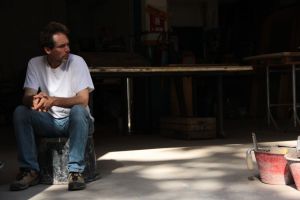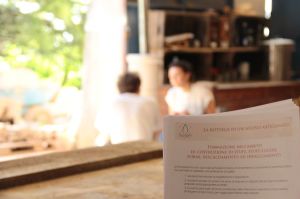Text: Silvia Pergetti
Photography: Damiano Razzoli
In 1994, beyond the Alps, our neighbour Axel puts aside jazz music and starts engaging with another art form: he learns how to work wood, metal, glass and textile at Nuremberg Werbund Werkstatt, a training institute following the Bauhaus method. There he develops his own, unique understanding of craftsmanship, combing functionality and aesthetics. In 2002 a Bavarian acquaintance encourages him to join a renovation project of an ancient villa on the shore of Lake Cavedine, Trento: the project team, made up by Germans, Swiss and Dutchmen, creates a one-of-a-kind architecture. The cooperation with a German stove designer follows, bringing Axel to explore the great variety of the Italian peninsula, refine his style and improve his Italian. Eventually, with the savings achieved through some joinery works, he founds Stufe d’Arte in Reggio Emilia: love, rather than the humid weather, makes him stay.
Costs, revenues and projects
 Axel designs stoves, kilns and fireplaces in his workshop in Regnano, and builds them directly at the customer’s place. Axel owns several pieces of equipment, among them the traditional grinder known as Molazza. Customer’s personality, design of the house, energy efficiency: all flow into a custom-made product. As work is discontinuous, Axel has no employees but has devised alternative forms of cooperation: sometimes the customer himself helps out, saving on the cost of the final product; other times fellow craftsmen, willing to learn new techniques, only charge for travel and accommodation costs. Axel is currently experimenting modular, easily replicable stoves and low-cost wall materials in order to expand the narrow customer base. Recently, Axel has endorsed a change in the business strategy: Stufe d’Arte will turn into La bottega di un nuovo artigiano, a training institute for stove designers.
Axel designs stoves, kilns and fireplaces in his workshop in Regnano, and builds them directly at the customer’s place. Axel owns several pieces of equipment, among them the traditional grinder known as Molazza. Customer’s personality, design of the house, energy efficiency: all flow into a custom-made product. As work is discontinuous, Axel has no employees but has devised alternative forms of cooperation: sometimes the customer himself helps out, saving on the cost of the final product; other times fellow craftsmen, willing to learn new techniques, only charge for travel and accommodation costs. Axel is currently experimenting modular, easily replicable stoves and low-cost wall materials in order to expand the narrow customer base. Recently, Axel has endorsed a change in the business strategy: Stufe d’Arte will turn into La bottega di un nuovo artigiano, a training institute for stove designers.
Why engaging in a business activity?
 Five years ago I was living from hand to mouth, von der Hand in den Mund as we say, but with a family priorities change. Demand for stoves was sufficient for me to set aside joinery and start my own business. Self-employment allows me to escape the daily routine of “everyday the same soup”: I believe in the social, technologic and aesthetic value of custom work. The drawback, if any, is that there is no separation between work and personal life.
Five years ago I was living from hand to mouth, von der Hand in den Mund as we say, but with a family priorities change. Demand for stoves was sufficient for me to set aside joinery and start my own business. Self-employment allows me to escape the daily routine of “everyday the same soup”: I believe in the social, technologic and aesthetic value of custom work. The drawback, if any, is that there is no separation between work and personal life.
EU immigrants and non-EU immigrants: do you feel you are a privileged immigrant?
I say it often as a joke, I am a first-class immigrant.
Aesthetics is important to you. Being German, is it challenging to read Italian aesthetic taste?
 It is not. Italy demands aesthetics much more than Germany does. Germans focus on functionality, on innovation, this is the strength of Germany; however, they don’t lay the same emphasis on beauty. In Italy my desire for aesthetics is satisfied. Unfortunately, stove designers mainly follow the same, old majolica tradition, and stoves are industrially manufactured, with no customization: there is a limited drive for innovation.
It is not. Italy demands aesthetics much more than Germany does. Germans focus on functionality, on innovation, this is the strength of Germany; however, they don’t lay the same emphasis on beauty. In Italy my desire for aesthetics is satisfied. Unfortunately, stove designers mainly follow the same, old majolica tradition, and stoves are industrially manufactured, with no customization: there is a limited drive for innovation.
In Italy doing business means building social networks. Was it hard for a Northern European to penetrate the local economic fabric?
 We call it Schneeballprinzip, snowball effect: the word of mouth made my products known, and my life easier. Moreover, my mentality is not too different from the Italian one: I am a German terrone. The stiff, meticulous, punctual German is a species that is much more widespread in the North, while South Germany is land of philosophers and dolce vita.
We call it Schneeballprinzip, snowball effect: the word of mouth made my products known, and my life easier. Moreover, my mentality is not too different from the Italian one: I am a German terrone. The stiff, meticulous, punctual German is a species that is much more widespread in the North, while South Germany is land of philosophers and dolce vita.
In Germany, know-how (to make) has a long-standing tradition. Does manual work enjoy the same prestige in Italy?
 I don’t think so. Improvisation is the strength of Italian people. There is a widespread belief that the better equipment you have, the more skilled you may become, but if you lack the fundamentals… In France, as in Germany, aspirant craftsmen undergo a three-year training period before they are allowed to start their own business. Italian craftsmanship is not fully valorised, and people are not fully aware of the fame it enjoys abroad. Think about the Venetian trowel: in Italy it is known as American trowel!
I don’t think so. Improvisation is the strength of Italian people. There is a widespread belief that the better equipment you have, the more skilled you may become, but if you lack the fundamentals… In France, as in Germany, aspirant craftsmen undergo a three-year training period before they are allowed to start their own business. Italian craftsmanship is not fully valorised, and people are not fully aware of the fame it enjoys abroad. Think about the Venetian trowel: in Italy it is known as American trowel!
What do you expect from the future, in Italy or in Germany?
 I am not interested in going back to Germany. Since the birth of my son, my wife and I have been discussing a lot about his future: Italian concept of family is quite different from the German one, you know. I started feeling the desire to build something that could give hope to a generation with a murky future: I thus developed the idea of the teaching lab, aiming at combining professional training with attention to aesthetics and social aspects and at bringing new dignity to craftsmanship.
I am not interested in going back to Germany. Since the birth of my son, my wife and I have been discussing a lot about his future: Italian concept of family is quite different from the German one, you know. I started feeling the desire to build something that could give hope to a generation with a murky future: I thus developed the idea of the teaching lab, aiming at combining professional training with attention to aesthetics and social aspects and at bringing new dignity to craftsmanship.
What kind of music is better suited to depict the spirit of your enterprise and your products? Schumann? Die Ärtze, die Toten Hosen, Paul Kalkebrenner?
Even die Ärtze? Both classic and rock music well depict custom work, improvisation, harmony, the ability to go beyond form and mathematics. Anyway, it must be a kind of music able to portray images.


